ISSN ONLINE(2278-8875) PRINT (2320-3765)
ISSN ONLINE(2278-8875) PRINT (2320-3765)
| Saravana.S Assistant Professor, Bharath University,Chennai – 600073, India |
| Related article at Pubmed, Scholar Google |
Visit for more related articles at International Journal of Advanced Research in Electrical, Electronics and Instrumentation Engineering
Wireless Sensor networks are finding multiple applications and are being increasingly deployed in the real world in various applications including military, industrial applications, remote sensing etc. Wireless sensor network is composed of many number of sensor nodes for sensing real time data. Each node communicates with each other by a wireless link either by directly or through the other nodes. Sensor nodes are powered by a battery supply, conservation of energy, which is directly related to network lifetime, is considered relatively more important than the quality of data sent. The lifetime of a sensor network depends on its node's energy. In most of sensor networks there is no way to charge node's battery, therefore efficient use of available energy sources is essential. In order to use the energy efficiently, an energy aware routing protocol which finds the best least cost between two nodes and finds the shortest route for real time data transmission is proposed, which not only has optimal energy consumption but also has the minimum end to end delay.
Keywords |
| Energy aware routing protocol; Real time traffic; Quality of service; Wireless Sensor Networks |
INTRODUCTION |
| Wireless sensor networks (WSNs) have gained worldwide attention in recent years, particularly with the proliferation in Micro-Electro-Mechanical Systems (MEMS) technology which has facilitated the development of smart sensors[1]. These sensors are small, with limited processing and computing resources, and they are inexpensive compared to traditional sensors. These sensor nodes can sense, measure, and gather information from the environment and, based on some local decision process, they can transmit the sensed data to the user. |
| Due to the limited battery capabilities, sensor nodes suffer an energy resource constraint [2] such that if there happens to be a failure of even a single node, the whole network topology changes requiring the network setup to be initiated again. This means that the life time of the network greatly depends on the life time of the individual nodes in the network of sensor nodes. Since sensor nodes are deployed to monitor events happening in a particular region, there is always a sink node or base stations to which the sensing nodes have to route the Sensed data for processing. The main advantage of the sink node is its prolonged energy supply since it is always accessible and therefore it always guarantees that if sensed data reaches the sink node, then the Probability of losing the Sensed data is reduced which is not the case for the source nodes. Node failure can be due to battery outage since sensor nodes are equipped with a fixed source of battery power [3]. An important factor that influences the consumption of more power in wireless sensor network is that each sensor node consumes power not only for sensing but also for processing the sensed data and transmitting or receiving data to or from its neighbors. These are the reasons for which the efficient use of power is the primary and perhaps the most important consideration for designing a wireless sensor network routing protocol. |
| Routing protocols [4] in wireless sensor network are designed in such a way that they keep the network life time for a longer period by efficiently utilizing the available resources in the most economical way and routing protocols also should use appropriate algorithm to find routes with ability to satisfy application QoS requirements. The sensor nodes in WSNs have many limited sources of energy and computing. The main constraint of these networks is the amount of energy consumption. The lifetime of a sensor network depends on its node's energy. In most of sensor networks there is no way to charge node's battery; therefore efficient use of available energy sources is essential. With respect to all above mentioned points, the protocols in wireless sensor network should consider energy constraint in all network's layers. Also routing protocols should use efficient algorithms that consume energy optimally [5]. |
| A number of factors do influence the design of routing protocols for wireless sensor network. They are node deployment, energy consumption, scalability, data aggregation, coverage and connectivity [6]. There exist a number of routing protocols classified according to network structure. They are hierarchical routing protocols, flat routing protocols and Location based routing protocols [7]. In flat routing protocols, all nodes in the sensor network have equal roles in gathering information. They all have the same information about the state of the network. Some of the flat routing protocols that have been proposed include: Directed Diffusion, Spin, Rumor routing, Minimum Cost Forwarding Algorithm, Gradient Based, Cougar, and Acquire [8]. In this paper a flat routing protocol has been proposed. |
| In this paper an efficient energy award routing protocol for real time traffic in wireless sensor networks has been proposed. The proposed routing protocol is energy aware so its main goal is to consume energy optimally. The proposed routing protocol can find the best route which not only has the optimal energy consumption but also has the minimum end to end delay. The routing algorithm in the proposed protocol, considers a cost function which helps the algorithm to assign a cost to each route. This cost function could be determined based on the application requirements. The proposed algorithm finds the best route depends on its cost. By using a cost function, the proposed routing algorithm selects an optimal route with possible lowest cost. The cost function is based on energy consumption and end to end delay. The end to end delay consists of transmission delay and queuing delay [9]. In the proposed algorithm, there is an attempt to minimize end to end delay by minimizing transmission delay. As transmission delay is directly related to the route length, the minimum transmission delay can be achieved by minimizing route length between source and sink nodes. The proposed routing protocol uses a neighbor discovery algorithm to find its neighbors uniquely. As most of routing algorithms need to send data to a specific neighbor, neighbor discovery is very important. The proposed neighbor discovery algorithm uses three input parameters includes: node identifier (ID), received signal strength and a random number. Simulation results show that it can discover the neighbor uniquely. |
| The rest of the paper is organized as follows: Section II gives overview of related work. Section III describes the proposed energy aware routing protocol in details. The implementation details and the performance analysis are discussed in section IV. Section V contains the simulation results and finally section VI concludes the paper. |
RELATED WORKS |
| Many routing protocols have been developed for wireless sensor networks till now. As the energy is an important constraint of the WSNs, so the energy aware routing algorithms are too important. In the rest of this section we review some of the general routing protocols proposed for wireless sensor networks. Directed Diffusion [10] is a well known routing algorithm for wireless sensor networks. This algorithm is not complicated and directly diffuses the data related to sensor nodes. This procedure guarantees high data delivery rate and low delay for communications. Directed Diffusion consumes more energy to forward and receive redundant data. Sink sends interests to each network nodes and determines their job. When a node senses an event, it sends appropriate event related information to sink. |
| Low-Energy Adaptive Clustering Hierarchy (LEACH) [11] protocol is also the very commonly used in sensor network for sensor network. The LEACH has the hierarchical structure and clustering routing method, LEACH partitions the sensor nodes into many different clusters, each cluster have a head node to collect the data of the other nodes in the same cluster and sending the collected data to the other cluster head or sink, but the nodes which is not the head between different clusters could not communicate with each other. The head node will be chosen randomly in the cluster, it causes the more energy consumption of the head nodes. By taking advantages on the data aggregation and chosen the head nodes randomly, LEACH would disperse the energy dissipation of nodes to enhance the lifetime in sensor network, but the longer communications between the head nodes or sink may increase the energy depletion by comparison. |
| The Power-Efficient Gathering in Sensor Information Systems (PEGASIS) [12] is the familiar reactive routing protocol for sensor network. Similar to the LEACH, the PEGASIS have a leader node to transmit the data to the sink. But the sensor nodes would not report data in periods by PEGASIS. When there’s any detected event, the route will be created as a chain by Greedy algorithm, there’s one node will be selected as the leader node to gather the data which is transmitted by other nodes along the chain. This reactive model can reduce the energy depletion by switching off the leader node and the Sensor nodes in turns and it can also decrease the frequency of the communications of sensor nodes. But the PEGASIS needs the location-aware device to create the chain for data transmissions, and that will also cost the more overheads of the node. |
| Real time Power Aware framework (RPTAW) considers both energy [13] and QoS metrics. This algorithm acts hierarchically. By changing cluster structure and creating new node which is called Relay Node that its job is forwarding information from cluster to sink, its goals are achieved. This algorithm claims that by using data aggregation functions, energy consumption is reduced. Furthermore it can manage quality of service depending on efficiency of routing protocol used. |
| Reactive Energy Decision Routing Protocol (REDRP) [14] is another routing algorithm for WSNs that its main goal is optimal energy consumption. This algorithm attempts to distribute traffic in the entire network fairly. Using this mechanism, it decreases total network energy consumption. REDRP is routing reactively, and uses residual node energy in routing procedure. It uses local information to routing, but nodes have a global ID which is unique for the entire network. This algorithm is divided into 4 steps. In the first step, sink sends a control packet to all network nodes. The nodes estimate their distance to sink relatively by using this packet. Next step is route discovery. Routing is performed on demand in REDRP. This means that the routes are established reactively. After route establishment in route discovery step, data are forwarded to sink by using those routes. In route recovery step if a route is damaged, it will be recovered or a new route will be established. |
PROPOSED PROTOCOL |
| The proposed protocol uses a flat routing algorithm [15] in which routes is established before traffic transmission. The algorithm is run to find the least cost route between the source and sink. The proposed routing algorithm is divided into 3 phases which are: route discovery phase, data transmission phase and route recovery phase. The last phase is only done when the topology has been changed. Each node has a unique identifier (ID) which is determined in the route discovery phase. The nodes also have a routing table which includes 3 fields: ID, signal strength and route cost. There is a record for each neighbor of a node in its routing table. The routing table is created in the route discovery phase. This table is used in data transmission phase to send traffic from source to sink. The three phases of the routing protocol are described in the following sections |
| A. Route discovery phase |
| Sink will be the initiator of this phase, and it broadcast a packet to its entire neighbor which is called as the route discovery packet. The route discovery packet is shown in the Fig.1 |
 |
| Each Route Discover packet consists of three fields which are: message type, sender ID and best route cost. The message type field determines the type of packet. The sender ID field determines the value of sender's ID. The best route cost field determines the cost of optimal route between sender node and sink[16]. Usually the value of sender ID field in all Route Discover packets which are sent by the sink node is equal to zero. As the cost of optimal route between sink node and itself is always zero, so the value of best route cost field is also equal to zero. |
| After receiving the Route Discover packet, each node follows these steps: |
| 1. The node increments the value of sender ID field in the received packet and compares the result with its ID. If the result is bigger than the node's ID, the received packet is dropped. Otherwise the node's ID is replaced by the value of the result. When the node doesn't have any ID, the node's ID is equal to: sender ID +1. If packet is accepted the steps are continued as follows: |
| 2. The node creates a new record for new received packet in its routing table. The ID field of the routing table is set to the value of sender ID field of the received packet. |
| 3. The forwarding cost of packet which is sent directly from node i to j is calculated using the following cost function: |
 |
| Where |
| distanceij -distance between node i and j. |
| energyj -Residual energy of node j |
| Definition of ETXp: The path ETX [17] is the maximum of the sum of the ETX’s of any three successive hops in a route. This computes the amount of bottleneck. N is the number of hops. ETXj is the ETX value of the jth hop. The number of bottleneck links may vary according to the network density. |
 |
| Definition of delay: The end-to-end delay of a packet in a network is the time it takes the packet to reach the sink from the time it leaves the source. |
| Where |
 |
| The ETX represented in (3) of a link is the predicted number of data transmissions required to send a packet over that link |
| Where |
| df - Forward delivery ratio |
| dr - Reverse delivery ratio |
| N – Number of hops |
| ETX – Expected Transmission count |
| Cost assigned to each link in the network is represented in (1). Each node to transmit its data toward sink, selects the optimal route which has least cost. If the new discovered route has a lower cost than the existing least cost route, the node replace the new discovered route as its best route to the sink. In this case, the sender of packet is chosen as the next hop node. As the routing strategy is hop by hop, so each node only stores information about its next hops. |
| 4. Distance between the sender and the receiver is determined by the signal strength of the received packet, and then the value is updated in the signal strength field of the routing table. Using the distance the transmission delay can be determined. For a better throughput the expected transmission count is added. |
| 5. If in steps 2, 3 and 4 any changes occur in the values of node properties, the node should send a Route Discover packet to its neighbors containing the new value of the parameters. |
| In the proposed algorithm, each node receives Route Discover packet from all its neighbors. It selects the lowest neighbor's ID as its ID. When all nodes send the Route Discover packets, the value of best cost route field in their routing table is set to the value of least cost route. At the end of route discovery phase, each node knows the cost of sending data from itself to the sink node. |
| B. Data Transmission Phase |
| When a node detected an event, it should send data related to that event to the sink. As mentioned before, the routes are established in the route discovery phase. All nodes know their least cost route to the sink. So, using the optimal path the node will be able to send its data to the sink. Each node knows its next hop in its least cost route. When a node detected an event or received any data, it sends them to the sink node via its next hop node. |
| C. Route Recovery Phase |
| This phase is executed periodically. The length of time periods depends on the node's mobility. If a node dies, it will never participate in the routing procedure in the next period. Therefore, the dead nodes are not belonging to any established route. If the next hop node is failed, the data are sent using a backup node. All nodes in the network know the cost of forwarding information through their neighbors. When the least cost route is failed then the node forwards data using the second least cost route. As the information about all the possible routes from a node to sink is stored in the node routing table, so it is easy to find the first and second least cost routes. |
| When the reminding energy of a node is less than a predetermined threshold, it will inform this situation to all its neighbors. If a node realizes that its next hope node doesn't have any sufficient energy, it uses its second least cost route to send its data. |
PROPOSED NEIGHBOR DISCOVERY PHASE |
| The operation of the proposed neighbor discovery phase is explained in this section. All energy aware routing protocols need neighbor discovery mechanism. Proposed approach uses a hop by hop routing algorithm; route to the sink is selected by each node via choosing next hop, meanwhile different routes are picked out by considering different next hop nodes. Most of routing algorithms use hop by hop strategy which is more efficient. All nodes which use hop by hop routing algorithm need information only about their next hop, which means they just need local information. When an algorithm needs to have a global view of the entire network, it absolutely must pay much more in contrast with the situation with only local view. Neighbor discovery algorithms collect local information about node's neighbors. To distinguish nodes from each other, we can assign a unique identifier to each node. This identifier makes enable the other nodes to select one node uniquely. By considering this deployment, all the node's neighbors will receive the data, but only one node that is identified by the packet destination identifier field will process it. The node's identifier could be local or global. When a node's identifier is global, the node could be identified by the other nodes uniquely. But as we mentioned before, this type of identifying is too expensive. When a node uses local identifier, it can only distinguish its neighbors. As the proposed algorithm needs network's nodes to distinguish their neighbors uniquely, so it doesn't need global identifier and the local identifier is sufficient. In the following, we propose a new neighbor discovery mechanism for distinguishing node's neighbors. |
| In the proposed neighbor discovery mechanism, each node estimates its distance to the sender using received signal strength. This parameter can be used for distinguishing node's neighbors. In the route discovery phase many packets are transmitted between nodes. Using the signal strength of these packets, the receiver can estimate its distance to the sender node. Therefore at the end of route discovery phase all nodes know their distance to their neighbors. In the route discovery phase an ID is assigned to each node. This ID is not unique in the entire network. The nodes with equal ID have the same number of hops to the sink. The proposed neighbor discovery algorithm uses both node ID and received signal strength to distinguish neighbors with a suitable accuracy rate. We believe that by using the distance between two nodes and the node ID, we can distinguish the neighbors with a high accuracy. If by using these two parameters, the node couldn't distinguish all its neighbors, this means that some of its neighbors have the same distance and ID. In this case, the proposed mechanism uses a random number to discern them. |
| When a node detects a collision, this means that it has more than one neighbor with the same distance and ID. It sends a Collision Recovery packet to the neighbors. In this packet the sending node advertises that only the nodes which detected any collision should process it and the other neighbors should ignore it. When the nodes which detected collision receive this packet, they create a random number between 0 and MAX (usually MAX is a big number, e.g., 100000) and send it for the node that has sent the Collision Recovery packet, using Collision Recovery Reply packet. Both sender and receiver, store this random number in their routing table in an appropriate record. This random number makes distinguishing action complete. By using distance (signal strength), ID and if needed the random number, it is possible to distinguish neighbors from each other. When a node wants to send a packet to one of its neighbors, it should use all of 3 mentioned parameters in the packet. All neighbors receive the packet, but only the neighbor which can find a match and has the same properties will process the packet and the other nodes will ignore it. To evaluate the performance of the proposed neighbor discovery phase, we implemented it in a simulator. Table 1, shows the simulations results. As mentioned before, the collision is only occurred when a node has more than one neighbor with the same distance and ID. |
SIMULATION RESULTS |
| In this section using GloMoSim network simulator software the performance of the energy aware routing protocol is evaluated with that of the AODV protocol. |
| A. Environment setup |
| Table 1 shows the network environment setup under which the energy aware routing protocol is simulated |
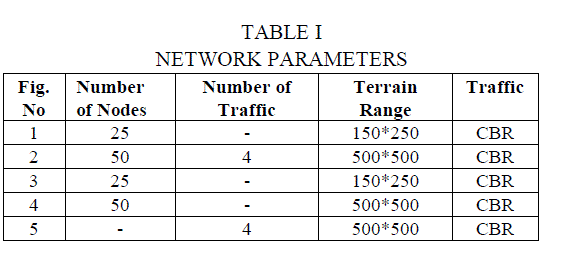 |
| B. Results analyze |
| In Figure 1 the average energy consumption of all the nodes is plotted versus number of traffic. When number of traffic increases the node utilization of the network also increases because of dense traffic, hence the energy consumed by the nodes increases with that of increase in traffic. When compared to that of AODV protocol the proposed energy aware protocol consumes less energy. |
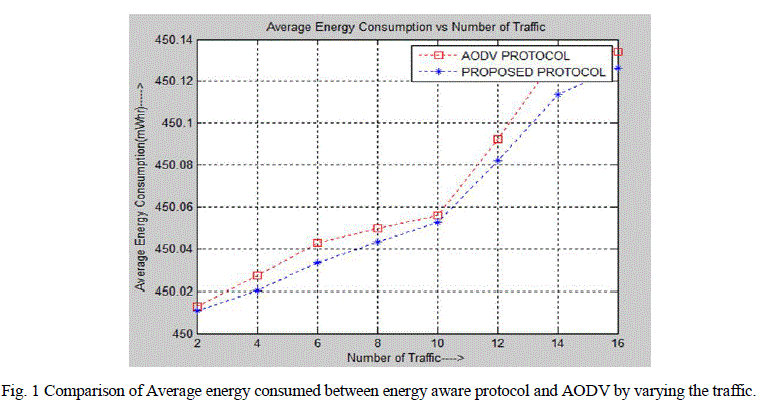 |
| Figure 2 compares the average energy consumed between the proposed protocol and AODV protocol by varying the packet size. Packet size represents the size of the data packet routed through the nodes. When packet size increases the routing time is also get increased which results in increased node utilization time, due to this the network energy consumption is also increased. As because the proposed routing protocol proactively establishes the route by least cost route it performs better than the AODV protocol. |
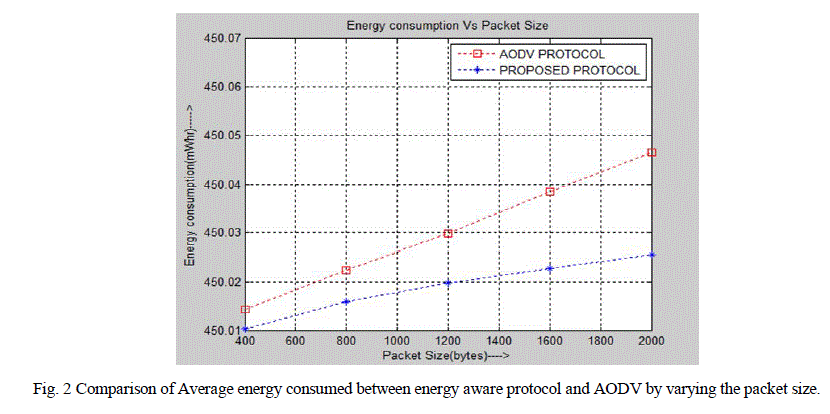 |
| The average end to end delay by varying the number of traffic is analyzed in Figure 3 by a comparison between the proposed protocol and the AODV protocol. The proposed protocol establishes a least cost route which has less number of hops to reach the sink node, hence the end to end delay for the data packet to reach the sink node also get reduced. This concept looks better than the AODV protocol routing technique. |
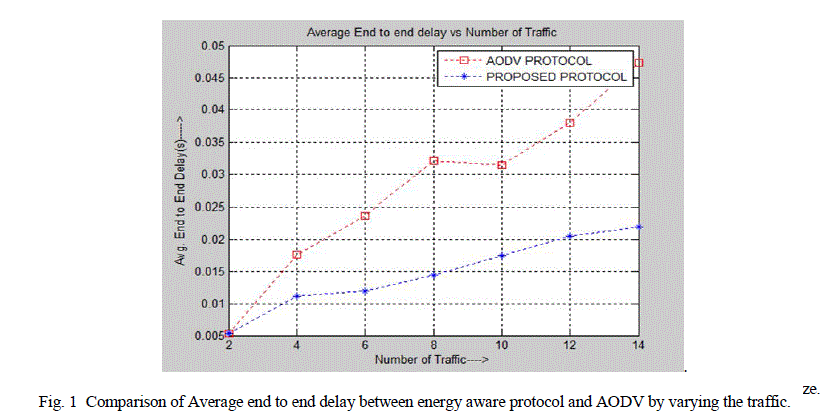 |
| Throughput of the network in analysed in Figure 4 for proposed method and AODV protocol by varying the number of traffic. As traffic increases the collision in each node get increased which results in decrease in throughput of the network. Proposed protocol performs better in such condition than the AODV protocol. |
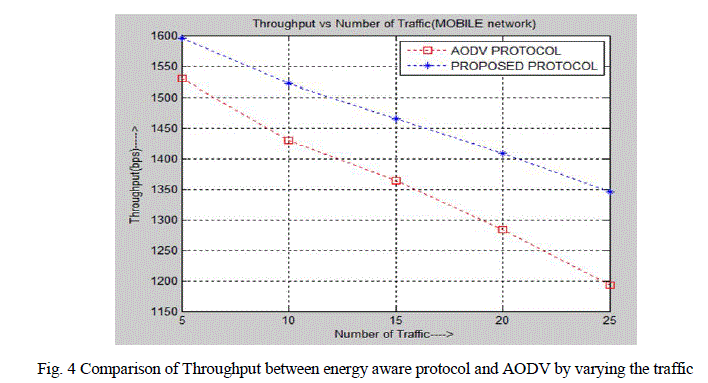 |
| Figure 5 compares the throughput of the energy aware protocol and the AODV protocol by varying the number of nodes in the network. As the node density of the network increases the number of hops also increases for the data packet to reach the sink node from the source node. Proposed protocol selects the route with minimum hop counts hence congestion of network decreases and collision rate also decreases which results in better throughput. |
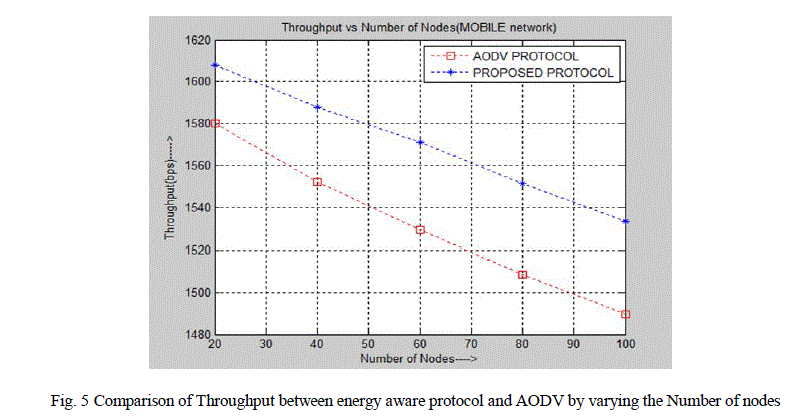 |
CONCLUSION |
| Energy aware routing is most challenging issue in wireless sensor networks. Current research on routing of sensor data mostly focused on protocols that are energy aware to maximize the lifetime of the network, scalable for large number of sensor nodes and tolerant to sensor damage and battery exhaustion. In this paper an efficient energy aware routing protocol was proposed. The proposed routing protocol has two major goals which are low power consumption and high delay performance. We evaluated the performance of the proposed protocol under different scenarios. Simulation results confirmed that the proposed protocol is more efficient in energy consumption in comparison with the traditional AODV protocol. Furthermore, the proposed routing protocol can find the optimal path with a low end to end delay and high throughput link. |
References |
|